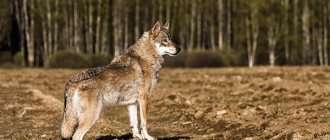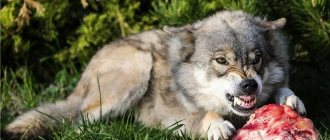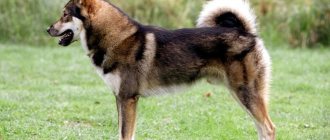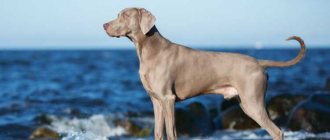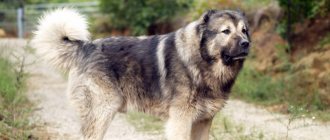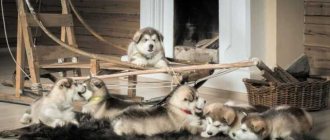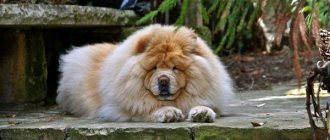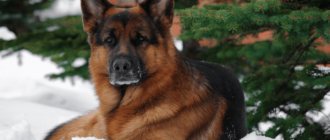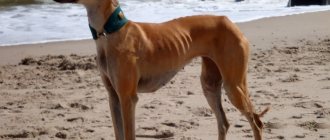What is known about the wolfdog breed
As you know, many years ago wolf-dogs appeared completely by accident. This dog, crossed with a wolf, was not tamed and showed aggression. That is why dog handlers were unable to make her an obedient pet. Then scientists made many attempts to breed a new breed, but they were unsuccessful, since the wolf instinct predominated in the bred animal.
For the first time, the most successful attempts to breed the wolf-dog were carried out by Russian dog handlers at the end of the twentieth century. At this time, excellent wolfdog puppies were bred in the Czech Republic. The animal had the appearance of a shepherd and the best physical characteristics of a predator.
Only at the end of the twentieth century did scientists finally get a good puppy by crossing a dog with a wolf
In order for the rather complex process of crossing to be successful, the wolf was accustomed to human society from early childhood. He had to understand that people are not enemies. Externally, the wolf-dog has the color of a wolf - the genes take their toll. An adult wolfdog has a massive and strong build, very strong paws and quite powerful jaws.
Distinctive features
The wolfdog differs from both the dog and the wolf . Representatives of this breed are very similar in appearance to a wolf, but in their obedience and devotion to humans they are similar to domestic dogs. Wolfdogs are smaller in size than a wolf, but larger than a dog. This breed combines all the traits of its parents equally:
- Size and weight: male – 60 cm and 50 kg; female – 55 cm and 40 kg.
- Head: elongated, proportional to the body.
- Eyes: almond-shaped, amber or light brown in color.
- Ears: triangular, protruding, medium size.
- Nose: developed, wide nostrils, color only black.
- Neck: dry, at an angle of 40˚.
- Paws: The front legs are straight and narrowly set, the paws are turned out, high, muscular.
- Torso: fit, muscular.
- Tail: set high, reaching to the metatarsus, thick.
- Coat: thick, with undercoat.
- Color: wolf (from light gray to dark, brown and black).
Education and training
Wolfdogs are trained according to methods developed by military structures. So, it is based on the following basic steps:
- training in obedience and following commands;
- training to memorize certain knowledge.
Trainers of this breed note that these animals very quickly remember commands literally the first time, even if these commands are highly complex.
Wolf dogs should be trained by persons with special education
By the way, loyalty to a person is also achieved through training. In order for a dog to become a dog and not a wolf, you have to train it from a young age, starting with a playful, tiny puppy.
Wolfdog character
Determining the character of this breed is quite difficult. After all, it is impossible to say exactly how many wolf genes a newborn puppy has. Namely, the character of the animal largely depends on this. However, the wolf and the German shepherd still have common features that are immediately visible.
These animals have a rather complex character. Most often, wolfdogs are raised by experienced specialists for official purposes. Remember that talk about the uncontrollability and aggression of this breed is a real myth. The puppy will become angry if the owner does not take care of him.
If the pet's parents include German shepherds, the wolf-dog hybrid will have a dark color
It is simply impossible to foresee in advance what kind of character your wolf-dog will have. If the wolf's blood content is within the permitted norm, then no problems will arise in raising the dog. This mixture of genes is very interesting, but it is precisely this that can give the character of an animal rigidity.
Description of the hybrid
Externally, the dog-wolf hybrid is very similar to its wild ancestors. By the way, he also has a breed standard with all the required characteristics. Let's look at it.
Weight and height
The weight and height of representatives of this breed can be called respectable. We will look at what exactly these indicators will be in the table below.
Table. Indicators of mass and growth of wolfdogs
| Weight | Height |
So, the weight indicators for a hybrid of a dog and a wolf will be as follows:
| As for height, it is also a secondary gender characteristic of the wolf and is measured at the withers of the animal:
|
This breed has many unique features
As you can see, the body parameters are quite impressive. Now let's move on to a more detailed consideration:
- bodies;
- limbs;
- heads;
- wool cover.
Body
The body of a wolf-dog practically replicates the outline of a wolf’s body in appearance, however, it is still more developed and has very strong and obvious muscles, which determine such physical characteristics of the wolf as:
- force;
- speed of movement;
- jumping range, etc.
Indeed, the wolfdog took only the best from its wild parent, as well as from the German shepherd, which was bred specifically to become an ideal human companion.
The powerful body of dogs is responsible for their incredible physical features.
Limbs
The limbs of a hybrid of a wolf and a dog are quite long, and it is they that allow representatives of this breed to:
- run very fast;
- jump long distances.
The hind limbs have more developed muscles than the forelimbs; All four paws are located parallel to each other, have elbows laid back, and length proportional to the body.
Wolfdogs have very long limbs, so they themselves are phenomenally fast
The wolfdog's tail is long and bushy, exactly the same as that of its wild parents. However, this is not the last detail of the exterior that hybrids adopted from wolves.
Head
The head of hybrids is wedge-shaped, ending in jaws with a scissor bite. According to statistics, the jaw of wolfdogs is several times more gripping than that of ordinary dogs, and the pressure is also stronger. According to cadets of the Perm Institute of Military Forces, if you train with wolf-dogs without protection, then it will simply be impossible to pull the training suit out of the animal’s mouth.
Wolfdogs have excellent hearing
On the head there are protruding ears, small, in the shape of an isosceles triangle. They hear not just well, but amazingly, as if these were not natural devices, but a spy microphone.
The eyes of these dogs, as a rule, have a light brown tint, like those of shepherds, but some representatives of this breed have the following shades of the iris:
- sand;
- gray-brown;
- nutty, etc.
The eyes of wolfdogs are not only beautiful, but also insightful. They look straight into the soul of their owners and express complete readiness to serve and follow given commands.
This representative of the canine family is very smart and willful.
Coat
The fur of wolf-dogs is exactly the same as that of wolves, but its shades can vary and mix with each other. For the most part, hybrids have a light gray coat with accents of the following colors:
- gray;
- dark gray;
- black;
- slate;
- sandy;
- brown;
- white, etc.
The color can be either uniform or spotted, with different patterns. Sometimes on the face of wolves there are areas around the eyes and at the nose, sometimes the face is completely light, without pigmentation.
The coat color of wolfdogs is predominantly light gray.
Lifespan
You will be surprised, but the lifespan of wolfdogs differs significantly from the lifespan of all dog breeds known to us today. So, if it is usual for a dog to live 18-20 years - this is a record, then for wolf-dogs the absolutely normal life span is 25 years. Such a long lifespan is a real gift for those who become attached to these dogs.
Wolf dogs live on average 25 years
Bite
We already mentioned above that the grip of hybrids is simply phenomenal. The bite force of these dogs and the pressure of their jaws is several times higher than that of their domesticated relatives, no matter how angry or large they are.
The wolf-dog hybrid has a powerful grip that is almost impossible to release.
Smell
Needless to say, a hybrid of a wolf and a dog is almost a wolf. Therefore, with the help of smell, he can smell many more different nuances of any smell, even at a great distance.
Pay attention to an interesting fact: studies have been carried out, thanks to which it became clear that wolves can distinguish by the smell of blood:
- healthy person;
- a person suffering from cancer.
Decreased affection
It should be said that wolf-dog hybrids rarely become attached to a person and, moreover, will not do this in spite of everything, like any other dog. However, there are still known cases when a wolf-dog not only fulfilled his duties, but actually gave his heart to a person, and then nothing could be more beautiful than this love between a two-legged and an animal.
Wolf dogs rarely become attached to their owner
Key Features
Among the general public, one can often hear statements about the uncontrollability, aggressiveness and inadequacy of wolf-dogs. To be fair, it should be noted that in the absence of upbringing, a hybrid may well exhibit negative temperamental traits.
However, the breed, in general, is considered to be quite sociable and trainable, prone to close relationships with the person chosen by the individual as a leader.
Despite the fact that the wolfdog is the result of human activity, the animal does not always meet certain standards.
In some cases, wolf-dog puppies are initially overly cowardly, which is explained by genetically embedded attitudes that do not provide for a relationship with a person. Such individuals are usually not used as service dogs.
Raising wolf-dogs should be carried out exclusively by persons who have undergone special training. This is due precisely to the presence of wolf traits in the genetic potential of animals. The dog perceives the relationship with a person from the position of “leader-subordinate”.
And if the teacher does not have enough strong-willed qualities and strength of character, which should be fully demonstrated during upbringing, the wolfdog will take the position of leader, that is, he simply will not follow commands and obey.
With proper training, a dog is a reliable and loyal friend who treats its owner with all possible loyalty and devotion.
In law enforcement agencies, wolf dogs are most often used in the most difficult, extreme conditions, where a dog of ordinary breeds such as Groenendael or Hovawart simply cannot perform the task required of it.
Characteristics and capabilities of the breed
The temperament of the dogs we are considering directly depends on the percentage of wolf DNA that gets into one or another individual. That is why it is not possible to clearly identify the specific traits of the temperament of these animals. However, they still have common nuances. So, we are talking about:
- increased physical activity;
- developed intelligence;
- adequate perception of what is happening around;
- intelligence;
- curiosity;
- pliability to training.
To establish contact with this dog, you need to start training it at a young age.
The valuable qualities of this breed determine its use for official purposes by the military forces of the Russian Federation. Thus, they are massively trained and used by police officers, customs officers, etc.
By the way, their physical and mental abilities also determine a certain severity of interaction, since such intelligent and strong animals cannot help but want to take a leadership position, including in relations with humans. This is why professionals should raise puppies from an early age.
Raising pure wolf puppies even from a very young age, dog handlers could not gain trust and obedience from them
The psychological endurance of wolf dogs also determines their rapid adaptation to most different conditions. Unfortunately, some wariness towards people, as well as distrust, still persist. Wolfdogs also retain some of the predatory habits of their ancestors. So, they will happily continue:
- catch small animals, in particular cats, mice, hamsters, rabbits and sometimes even small dogs;
- dig holes in the ground;
- show aggression in confined spaces.
Volksob is a dog for a specialist, not an ordinary citizen
Gallery: wolf dog (25 photos)
Appearance
The description of the breed is rather short and mediocre. The wolf dog should resemble a wolf in appearance and be large in size, the dimensions range within the following ranges:
- Height: 62–67 cm.
- Weight: 35–45 kg.
The build is identical to a wolf - a “dry” body structure, flat, toned sides, strong jaws with a “death grip”, a very large hand, long and sinewy limbs. The color is gray (wolf), all shades and varying degrees of color saturation are allowed.
If we move away from the rigid framework of cynology, a Wolfdog can be called any dog in whose veins the blood of a wolf flows. Fans of “outlandish” four-legged animals do not like to clarify what the percentage of “wild and domestic” blood is in their pet; the fact itself is important. Thus, in various sources you can find dogs with the same name, but completely different characteristics. For example, a peach or white Wolfdog, whose color pattern resembles a Belgian Shepherd, and the German exterior is obtained by multi-stage mating of Huskies, Laikas and the same German Shepherds.
Black Wolf Dog obtained by crossing a wolf and a German Shepherd. To be fair, we note that the chances of being closely related to a wolf are much higher for dark-colored individuals than for peach or white ones. The only and unshakable condition for all Wolfdogs is a domestic, adequate and balanced character (this condition does not apply to dominant sexual aggression).
Social structure and reproduction
Photo: Wolfdogs
Regarding reproduction - in principle, wolves, like dogs, can reproduce in captivity (for this it will be enough to provide each pair with a separate enclosure). But breeding mestizos in captivity is very problematic. Why is that? The difficulty is that wolves are monogamous (monogamous, preferring only one female and remaining “faithful” to her throughout their lives), therefore, under unfavorable circumstances, they can easily reject or even kill a dog.
The reason may be a banal “inconsistency with ideas about beauty.” Or simply a lack of acquaintance before mating. Moreover, only a wolf (or a wolfdog, if we are talking about breeding F2 offspring) chooses a female suitable for mating. What is most unpleasant is that males most often choose not those females with whom they would make the best wolf-dogs.
Interesting fact: The best hybrids were obtained in those pairs where the male wolf was loyal to humans, had balance, but was not cowardly. It is enough for a bitch to have a good psyche and exterior.
It makes sense to dwell separately on the dog breeds used to breed wolf-dogs.
So, the following are subject to crossing with wolves:
- Saarloos wolf dog;
- Czech wolfdog;
- unrecognized breeds.
Of the latter, the Perm wolf dog is the most popular - despite the official cessation of breeding these dogs for the needs of the army and border service, private breeders are actively crossing German shepherds and wolves, obtaining very decent results.
It is impossible not to dwell on the numerous hybrids unrecognized throughout the world - many of the representatives of these breeds have become reliable guards of households and family favorites.
For example:
- Russian Wolfhund - bred by crossing a black Canadian wolf with a Malamute;
- Russian Woland - a cross between a husky and a wolf;
- Haskovolves;
- Swisswulf.
Less successful examples of breeding wolfdogs include the Russian dog Sulimov - the breed is a cross between a jackal and a husky, the American Wolfdog, the Italian Lupo and the Kunming breed bred by Chinese dog handlers.
How to raise and care for an animal
Before you go to a wolf-dog nursery to choose a puppy, you need to think about why you need it and whether you can handle raising it? The fact is that wolf dogs are smart and incredibly complex animals. Only experienced people can care for and raise them more successfully.
Dogs are not meant to live in an apartment, as they need space. In a small and enclosed room, dogs will behave aggressively and inappropriately. Even small wolf and dog puppies can “destroy” an apartment in literally half an hour during the owner’s absence. In addition, they do not bark, and love to give long “night concerts.” This causes great concern to the neighbors.
Therefore, it is worth keeping the animal in a country house. It is preferable to place a warm booth on the site and build a spacious enclosure. It is imperative to ensure that the animal cannot leave the suburban area. After all, a wolf dog can independently escape in order to go into the forest forever or join a pack of stray dogs.
Usually the wolf-dog is not allowed into the house. Only in severe frosts can they be allowed to spend the night in their home. The biggest advantage of the animal is that it requires minimal care. The dog will stand near the door to the house and normally endure difficult weather conditions without showing concern.
Owner reviews
Yuri : “At work, such a little animal lived with us. I went to the border at the age of 18, and left at 32. So we were together all the time, we got along very well. Of course, you can't relax. But he became attached to the dog. There’s nothing scary with her.”
Valentina : “One day I was walking with my husband and daughter and wandered into a bird market. There, one girl was offering some very cute puppies. We took a closer look, but we didn’t like the mouth: the fangs were too terrifying. And then she told us that this breed, it turns out, was a mixture of a wolf and a dog. This has become truly scary! Moreover, they sell them without documents or any certificates, so they fled from there without looking back.”
Vladislav : “We live in a private house outside the city, there are no other houses nearby - just taiga. A colleague sent me a photo with a huge dog, I couldn’t stop looking at it. Then he said that it was a cross between a wolf and a dog and offered to buy a puppy. The price, of course, is astronomical. It was both scary and interesting. In general, we agreed that I was taking the puppy, but if something went wrong, I could return it. As a result, the dog grew up and was affectionate with us, but if one of the dogs wanders into the yard, it’s a disaster! All the dogs in the area were torn to pieces. I had to refuse. I feel sorry for them."
Konstantin : “I live in a village, and we have hooligans here - more than enough! The thief especially woke up when I went to work for 2-3 months, and my retired mother was left alone. She called, complained, cried: either the lock on the gate was broken, or the barn was broken into, and she was even scared. I bought her a Wolfhund, built her a kennel, and began raising her. Since childhood, I tried to be tougher with him, so that I knew who was boss in the house. I walked a lot in the surrounding area, but always returned safe and sound. During our departure we had to keep the dog in a kennel; my mother was afraid. They hired a special person to come and walk him. A 5+ defender, but of course it’s scary to approach him every time. There’s no escape from wild blood.”
Origin story
There are many known facts when dogs crossed with wolves, after which unusual offspring appeared. The first mention of hybrids appeared at least 10,000 years ago, when wolves were supposedly domesticated. There is an opinion that some wolf individuals independently joined people, without fear of them and treating them kindly. Further mating of closely related animals could subsequently lead to the emergence of a new family of canines, their main task was to participate and help humans during the hunt. Much later, a huge number of scientific breeders took part in the breeding of mixed dogs and wolves. And most often, all attempts to get a seasoned, brave, strong animal, combining the features of a domestic dog and a predatory wolf, ended in failure. This was explained by the fact that the cubs had an overly aggressive and sometimes cowardly character, an unstable psyche, and were practically not amenable to training. In addition, the bred individuals had multiple developmental anomalies that did not allow them to become real hardy service or working dogs. Today, there are about a dozen officially unrecognized breeds that appeared by crossing dogs of various breeds and wolves.
If we consider wolf-dogs as a breed, the founders are the cynologists of the Perm Military Institute, who, in the second half of the 90s of the 20th century, began studying the behavior and habits of wolves. Only those individuals that were tolerant of humans could be suitable for crossing with dogs. It is believed that among all predators of the wolf genus, no more than 5% of animals can be successfully crossed with dogs. The remaining 95% are extremely distrustful, aggressive, and unpredictable. It should be noted that in most cases, male-wolf and female-dog connections are used to breed offspring. But Perm dog handlers managed to get the first offspring from another union. In 2000, a mating took place between a she-wolf named Naida and a male German shepherd named Baron. Such a union became possible because Naida was raised by a hunter from childhood, who instilled in her those qualities that are inherent in a domestic animal, and not a wild one. The she-wolf, even having matured, remained positive towards people. The man who raised Naida subsequently handed her over to specialists at the Perm Military Institute, in whose kennel the future “father” of wolfdogs was kept - the black dog Baron, obedient and adequate. In the first litter in 2000, 5 puppies were born. Of the 4 survivors, only one wolf dog subsequently showed good results during his service at customs and border. The remaining animals showed a pronounced feeling of mistrust in humans, fear of new tests, technology, etc. The blood of the first litter of wolfdogs contained 50% wolf blood.
In 2001, another mating between Naida and Baron took place, after which 5 puppies were born, and only one of them was distinguished by its friendly attitude towards people, was trainable, but had a very independent and dominant character. Subsequently, in 2003, the she-wolf Naida was crossed with a male from the second litter, and the new puppies already had 75% wolf blood. Surprisingly, the puppies of the third litter turned out to be much braver than the previous ones, coped with the assigned tasks perfectly, did not shy away from people, and easily followed commands. Wolfdogs differed from dogs in their excellent health, great physical strength, and the most acute sense of smell.
Subsequently, Perm specialists bred several generations of wolf-dogs. To date, the experiment on breeding a hybrid at the Perm Military Institute is considered closed. However, there are nurseries in our country that breed wolf-dogs. The cost of a puppy starts from 15,000 rubles and above, and depends on the percentage of wolf and dog blood, the character and age of the animal. Most often, wolf and German shepherd mixes are purchased for service in law enforcement agencies.
Aggression of half-wolves
There is some controversy regarding the effectiveness of rabies vaccination in relation to wolf dogs. The US Department of Health has not yet approved vaccinations for half-wolves, and therefore ordinary vaccines are used. Breeders are confident that the government is not specifically developing a vaccine so that private owners will have fewer wolf dogs.
The aggressiveness of wolfdogs depends on the upbringing and socialization of each individual; there is no scientific evidence that these hybrids are more dangerous and aggressive. Large breeds such as Rottweilers, pit bulls and German shepherds can be just as dangerous.
Wolfdogs should not be considered more dangerous than other large dogs.
Wolfops behavior is not directly proportional to the amount of wolf blood in the animal: in the first generation, hybrids may have more typical canine behavior, and subsequent offspring may have wolf behavior.
There is no evidence that half-wolves pose a greater threat to humans than other dog breeds. Most often, the attack of these animals is associated with the irresponsibility of the owners.
What to feed the dog
As written above, the wolf dog is not demanding in terms of maintenance and does not need special care. Such a strong animal is also not picky when it comes to nutrition. For normal development, he does not need to purchase premium dog food that is popular today.
The dog needs natural nutrition, and even the highest quality and most expensive food can be harmful to the pet’s health. Prepare porridge for the wolf dog, which can be cooked in meat broth. The animal is allowed to be given liver, meat, dairy products, kidneys, vegetables and fish several times a week.
The content of protein foods in the menu should significantly exceed the level of foods filled with carbohydrates. With such nutrition, the animal will grow healthy, hardy and strong.
It is imperative to follow a daily diet. The dog should be fed no more than 2 times a day. If you feed your animal more often, this will lead to obesity, which negatively affects his health.
Necessary care
The great advantage of the wolf-dog is its unpretentiousness . He does not need to brush his teeth, comb his fur, or cut his hair. It is enough to periodically examine the ears, eyes, and the condition of the mucous membranes and skin.
Wash only when absolutely necessary (once a month), more often in summer.
Nutrition
Only natural food is suitable for wolfdogs . It can be cereals, meat and even vegetables. Moreover, raw meat and sea fish should be present in the diet daily. Ready-made food - both dry and canned - is strictly prohibited.
You can rarely give them marrow bones and sweets as treats.
Puppies need to be fed 6 times a day in small portions, gradually reducing the number of meals to 3.
Prohibited products:
- Legumes and nuts
- Millet
- Grapes and raisins
- Acorns and pistachios.
Nutrition
The wolf dog does not need careful grooming
The daily diet of wolfdogs is no different from the diet of large breed dogs. The animal does not require feeding with special dry food , as well as balanced dietary supplements. On the contrary, food of this kind is not suitable for these dogs.
The most optimal products for feeding wolfdogs are meat, cereals, and vegetables. Moreover, the protein level must certainly exceed the percentage of carbohydrates in food.
You can find out more about what cereals you can feed dogs here:
Hybrids are direct descendants of wild wolves, which does not exclude their manifestation of predatory habits. That is why it is not recommended to feed the animal raw meat, in order, let’s say, to exclude the possibility of the dog becoming addicted to blood.
There are also no direct indications for introducing any active dietary supplements or vitamins into the dog’s diet. Animals obtain all the substances necessary for a full existence from simple food.
Wolf dogs are used exclusively as service dogs.
Special parameters
What makes the wolfdog unique is its keen sense of smell. The animal is so intellectually and physically developed that it is able to distinguish a sick person from a healthy one, and can detect the presence of a cancerous tumor by smell. Instantly senses the trail and fear. No dog can boast of such abilities.
Unfortunately, it has not yet been possible to breed a fully socialized animal. All hybrids lack a sense of empathy and affection; they can only be trained to guard and obey. The wolfdog will not miss you if you go to work.
Lifespan
A wolf dog purchased from an official nursery lives for about 25 years. There are known long-livers who have successfully lived up to 30-40 years, although in the world of dogs 20 years is already considered a respectable age. Increased life expectancy is associated with an admixture of wolf blood. Even at 30 years old, the dogs did not lose their working abilities, except their sense of smell and sensitivity, they performed their service regularly and obeyed their owner. Animals live to such advanced years thanks to timely vaccinations, good nutrition and an active lifestyle with frequent training, including long runs.
Let's sum it up
A hybrid of a dog and a wolf is a fearless creature with a keen sense of smell and developed intelligence. This breed variety is used by the security forces of our country, as well as foreign countries. So, according to statistics, a wolf-dog can find a criminal in a certain space in about a minute - such is his keen sense of smell. Provided that the percentage of wolf blood in the body of a particular hybrid is 25%, you will get the best representative of the breed. The population of this type of dog today is very small; they are used mainly by law enforcement agencies, so it is not possible to buy them in Russia. However, in the near future their numbers will most likely increase, and you will be able to get yourself the desired puppy.
Interesting Facts
- A documentary film called “Special Purpose Dogs” was made about wolf dogs.
- Wolf Blue from the anime "Wolf's Rain" is a wolfdog, like the main character of "White Fang" by Jack London.
- In the cartoon "Balto" the hero is born from a she-wolf and a sled dog, thereby being a full-fledged wolf-dog.
- Wolf dogs are wary of people, in some cases they are capable of showing aggression and being extremely stubborn. However, most representatives of large guard breeds are prone to such manifestations. And they, like other dogs, cannot be beaten, otherwise the animal will become embittered and will not subsequently obey.
- In Germany, a few years ago, a poodle was crossed with a wolf. Almost nothing is known about the fate of this hybrid.
- Even the most domesticated hybrid individuals have some wild habits. They will never refuse to hunt small game, they love to chew and gnaw various objects, they dig real canyons, easily overcome any fences, and if they are closed indoors, they can destroy everything to the ground. Owners who decide to own such an animal are recommended to equip a spacious enclosure made of strong materials. They do not require special care, and their health can only be envied.
- There are 7 breeds of dogs related to wolves in the world. Through crossbreeding, four breeds were developed, of which only two received an official standard: the Saarloos Wolfdog and the Czechoslovakian Wolfdog. The first is the oldest hybrid breed, which was created in 1925. The Czechoslovakian wolfdog was bred in 1955 using a German shepherd.
- Wolf dogs today are not yet fully recognized, are not intended for home keeping and are most likely the exception. But still, people do not give up trying to improve the qualities of dogs at the expense of their closest relatives and create a unique breed with superpowers. Perhaps someday there will be a domestic wolf-dog that can be trusted even with a baby, and its sense of smell and strength will be used in everyday life. But this is still a long way off.
Video
Differences from a dog
So, let’s summarize everything we’ve learned about wolfops in comparison with dogs:
- Wolfhounds have a longer lifespan (about 25 years).
- They have stronger immunity, again compared to their long-domesticated relatives.
- Outwardly, they are more similar to wolves than any other breed of dog, even one as close in appearance to a wild ancestor as a German shepherd or husky. Because of their striking resemblance to wolves, hybrids are often featured in films as wild, four-legged forest bandits.
- Wolfdogs are amazingly hardy: for example, a German shepherd, periodically resting, can run 20 km, and a wolfdog can walk more than 150 km in a day, taking into account a 2-3-day hunger strike!
- The wolf dog is able to bite through protection made of felt and plastic. Wolfdog is no longer just a guard, but a serious weapon against an ill-wisher.
- They howl, not bark.
- The sense of smell is many times sharper than a dog's.
- Wolfops are superior to dogs in intelligence (for example, in 15-20 seconds they find a person or object in a limited area), and a dog does this in 3-4 minutes.
- You need to try hard to earn trust and respect; not every “sofa” pet will respect a weak-willed owner, let alone wolfops. Pronounced leadership qualities are the main requirement for the owner of a hybrid.
Shedding
The animal sheds twice a year, and sheds its “coat” quite profusely. It must be combed well with a furminator.
Health
Before buying a wolf-dog puppy, special services are interested in its health. The discovery was that the hybrid has high immunity and almost perfect health. It will survive in almost any habitat, adapting to anything. Therefore, the military takes four-legged animals with them to anomalous, radioactive and other zones.
Diseases, if they appear, disappear in wolfdogs in a matter of days, without relapses. So far, only rabies is fatal to them.
There are disputes on this issue between dog handlers from different countries. To date, it is not known whether a regular rabies vaccine helps hybrids, and a special one has not been invented. Some believe that this is not done intentionally to reduce the possibility of ordinary breeders keeping wolf dogs.
Application
Initially, the Czechoslovakian Wolfdog was bred to participate in military operations.
In modern life, the wolfdog's remarkable set of qualities has made it simply a universal dog.
It is good for search and rescue work, in protective guard duty, along with the Groenendael and Hovawart .
Heightened canine instincts and wolf health allow him to be a good hunter and tracker, and his devotion to the pack and fearlessness make it possible to use the dog to protect herds of domestic animals.
Czechoslovakian Wolfdog puppy looks like a little wolf cub
Psychology
Wolfdog puppies are raised from early childhood. It is generally accepted that the wolfdog is a difficult animal to train, which is highly aggressive, like a fighting dog, and does not get along well with humans. This is far from true. Hybrids bred by crossing a she-wolf and a German shepherd in the Perm region are predominantly endowed with the positive qualities that characterize any large breed dog. It is necessary to clarify that the term “wolf dog” itself is applicable exclusively to animals obtained as a result of crossing on the territory of Russia. In other countries, attempts have also been made repeatedly to breed wolves and dogs to produce hybrids. Of course, positive results were also obtained.
Thus, several new breeds were developed, some of which are officially recognized. As for the “wolf-dog” hybrid, these animals have the appearance of a wolf, as can be seen in the photo, and the potential, as well as the temperament, of a German shepherd. The level of aggression and inability of these animals to learn is directly related to the amount of wolf blood, expressed as a percentage. For example, wolfdog puppies, in whose veins no more than 15% wolf blood flows, are practically no different from an ordinary German or Swiss shepherd in terms of character and temperament. If the proportion of wolf blood exceeds 25%, the wolf dog may have a slightly increased temperament in terms of aggression, however, subject to the use of experienced training, negative qualities can be reduced. At the same time, such hybrids have a sharper sense of smell and endurance.
In general, the wolf dog is characterized as an animal with the following qualities:
- The wolfdog almost instantly navigates unfamiliar terrain. So, he can detect a person in a small area within a maximum of 30 seconds, while, for example, a Russian or Estonian hound dog will perform this trick in 3 - 4 minutes.
- Wolfdog puppies have good health and practically do not suffer from diseases that are inherent in young dogs of large breeds.
- Adults are also in excellent health and do not require vaccinations. There is an opinion that vaccinations given to a hybrid do not have any effectiveness, that is, they are simply ineffective.
- Wolf dogs are easy to train and are distinguished by their intelligence and intelligence.
- It should be remembered that only a person with strong leadership qualities, who is able to show a certain rigidity and force the animal to obey, can instill the right qualities in a hybrid.
- Despite widespread misconception, the wolfhound is not a hunting or hound dog, and is not adapted to hunting in tandem with a person.
Characteristics of Wolfops
Hybrids have a more developed sense of smell, they are stronger and smarter than ordinary dogs. In a closed room, they are able to find a person in 20 seconds, while a shepherd dog does this in 4-6 minutes. The wolfcop has the size and grip of a wolf, but at the same time it is obedient and gentle with its owner.
When buying a wolf-dog puppy, the “wolf content” is important, that is, the percentage of wolf blood.
There are 2 ways to determine this percentage: according to pedigree and by external features. But there are no uniform rules for both methods, since breeders can indicate the percentage that is best bought.
Wolf blood is responsible for the hybrid's appearance and behavior. But the more “wolf content” in a wolfops, then, contrary to established opinion, the animal turns out to be more distrustful and timid. More purebred dogs are braver and more aggressive, especially when crossed with appropriate breeds, such as terriers.
It is believed that the more hybrid wolf genes there are in the blood, the animal becomes more fearful and distrustful.
Conditions of detention
The breed is not officially recognized, so it cannot be kept on private property. Some unscrupulous breeders turn a blind eye to this and sell wolfdogs to ordinary people, although at the moment only law enforcement agencies have permission to purchase them in Russia. The animal must be kept in an enclosure equipped with a warm kennel, as it has irrepressible energy and enthusiasm for excavating the territory. The dog is not forbidden to run around the area, but you need to make sure that he doesn’t dig under the ground and run away. It is not forbidden to let a pet into the house (as evidenced by photos from the Internet), but it is impossible to keep it permanently in an apartment. He will destroy his home and become uncontrollable due to the inability to give vent to his emotions and physical strength. It is also prohibited to keep animals on chains. The result of such an event may be unpredictable.
Caucasian Shepherd Dog.
0 Being a rather stupid dog compared to the German Shepherd, this dog is intended primarily for protecting herds. Assertive, stubborn and fearless. However, it is often completely uncontrollable and ready to attack its owner.
0
Boxer.
Utonogan
This dog looks like a wolf that hasn't been shorn for a long time. The fluffier coat makes this breed adaptable to living in harsh environments. This cross between a German Shepherd, an Alaskan Malamute and a Siberian Husky makes an excellent companion dog for those looking to adopt a pet wolf. Possessing a cheerful and lively disposition, the utonogan will become a favorite of the whole family. The only thing you have to keep an eye on is that the utonogan inherited its appetite from its gray ancestor, so the diet needs to be balanced so that there are no problems with excess weight in the future.
Precautionary measures
If you type “wolf dog” in a search engine, the service will give you a lot of cute pictures confirming the friendship of a person and a beautiful, semi-wild dog. However, it is difficult to get along with him under the same roof. Animals are adopted by private individuals who have extensive experience in raising dogs and canine skills, as well as extensive territory that the pet requires for games and an outburst of energy. The wolfdog is not suitable for families with children. If you want to chat with an unusual beauty or introduce your children to the breed, it is better to visit the nursery. Under the supervision of competent specialists, you will spend unforgettable moments next to the most loving individuals, receive a lot of positive emotions and take beautiful photos. Some kennels produce dogs that love to cuddle. It is truly an incredible feeling to be hugged by a domesticated wolf weighing 70 kg.
It is worth starting a wolfdog breed of dog only if there is the possibility of strict training and compliance with all the necessary conditions of detention
Pet cost
It is worth purchasing wolfdogs from trusted breeders, in well-known nurseries that have been dealing with this breed for more than one year. The pre-pup is picked up at 4 weeks of age to begin training him when he is able to accept you as the leader. The price for a pet starts from $250 and goes up to fabulous sums, depending on the reputation of the breeder.
In today's article we told you about the unique quintessence of a dog and a wolf. These stunningly beautiful and powerful animals have won the hearts of many people, but only experienced owners can control them. Keep this in mind if you want to get yourself such a pet.
Upbringing
It is believed that the more wolf genes a representative of this breed has, the more difficult it is to raise him. In fact, even in one litter there can be both docile animals and wild ones with a wolfish character. Education is usually carried out by professionals, and it is aimed at developing service qualities - after all, this is not a couch potato, moreover, they are very active and willful. But what else can wolves be?
Wolf dogs are nocturnal animals, so it is best to train them in the evening.
Where to buy, puppy price
If you decide to purchase a puppy of this rare breed, then get ready to solve a number of difficult problems. There are no official kennels and breeders of wolf-dogs in Russia, and these dogs are not officially recognized by international canine organizations. These dogs are currently undergoing so-called field testing by the special services. It is extremely difficult to purchase a real wolf-dog; this can be done from unofficial breeders.
The price of such puppies ranges from 20,000 to 30,000 rubles, and it depends on the gender, color and origin of the puppy . However, this is associated with a certain risk, because it is unknown what percentage of wild genes such offspring have. As already mentioned, if it exceeds 20%, then serious problems with education will arise. But if you nevertheless purchased such a puppy and all its indicators are normal, then you will receive a faithful friend, guard and assistant for many years. Good luck to you!
How to choose a puppy
Relatively young breeds usually do not have genetic abnormalities or defects, this includes the Czechoslovakian Wolfdog.
The price of a puppy does not correlate in any way with its purebred, so there is no point in focusing on inflated amounts.
Important! One of the main aspects when choosing is the health of the baby’s parents. It would be good if the breeder can also provide their grading. This is a code of Latin numbers and letters, when deciphered you will learn about the dog’s proportions, its shortcomings and temperament, and its compliance with the standard.
The baby is resting
After checking the documents, you can begin to examine the doggies. Their health is assessed using the same indicators that apply to the selection of other puppies:
- cleanliness of eyes, nose, ears;
- good condition of coat and skin;
- softness and cleanliness of the tummy;
- presence of a pleasant smell;
- liveliness of temperament, curiosity.
The dog doesn’t care at all what size the one who offends his owners or their children is - the ill-wisher will experience all the ferocity of the wolf
